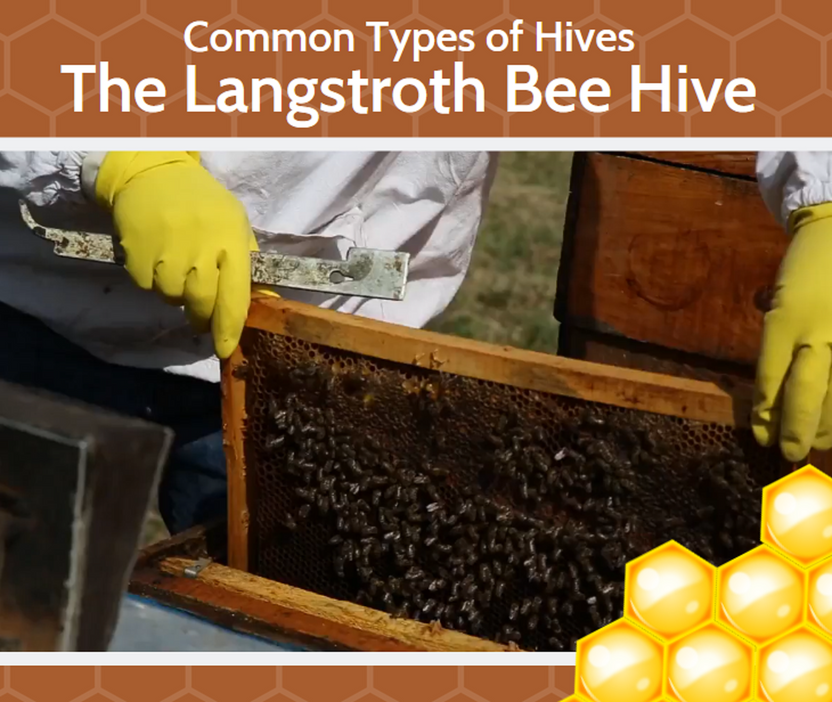Bee Hives - The Langstroth Hive
Posted by Scott Veriha on Mar 2nd 2020
 I am well on the mend, and into the recovery of my immune system, our
January thaw is over, the temps are dropping, but spring is coming, the days
are getting longer, and my Carolina Reapers are starting to poke up in their
seed trays. In the last article I
introduced you to the TBH, in this article I will give you an introduction to
the Langstroth hive, and the concept of Bee Space.
I am well on the mend, and into the recovery of my immune system, our
January thaw is over, the temps are dropping, but spring is coming, the days
are getting longer, and my Carolina Reapers are starting to poke up in their
seed trays. In the last article I
introduced you to the TBH, in this article I will give you an introduction to
the Langstroth hive, and the concept of Bee Space.

Pictured Above: Langstroth hives made up of 8 frame, medium, boxes. Hive in the background is made up of 10 frame, deep, boxes. Green Box is a Pollen Trap.
The Langstroth Hive is the most readily recognizable hive, it is the hive that we have all seen in pictures, painted white, and lined up in fields around the country. The Langstroth hive was designed, and patented, by Reverend Lorenzo Lorraine Langstroth in 1852. He discovered, and measured, what is commonly referred to as Bee Space. Reverend Langstroth did not invent bee space, the bees did, but he was the first to figure it out, and apply it, so that the moveable frame beehive was possible. The Langstroth hive is used by both hobbyist and commercial beekeepers. Their square, and compact, design allows them to be moved by semi-truck around the country for pollination purposes. The frame for these hives is completely surround by wood so can be used in extracting equipment, and can be moved easily with very little damage to the wax comb.

Pictured Above: Empty Langstroth Frames.
Their standardized sizes allow for uniform production of the hive components, and the harvesting of honey in mechanized extracting lines. Backyard hobbyists can also buy extracting equipment that will allow them to harvest honey without crushing the comb, as I have to do in order to extract from a Top Bar Hive.
In my third year of beekeeping I had a buddy who was unable to take care of his Langstroth hives due to a family emergency. I volunteered to look after them for the year, and moved two Langstroth hives to one of my bee yards. Doing so gave me an opportunity to try out this style of hive, and learn a little about their management. I had a successful summer with them, and even managed to make a little bit of honey. I’ve kept several Langstroth hives in my operation ever since.
Langstroth hive components come in three
main box sizes, measured by height, these are Deep, Medium, and Shallow Boxes.
Deeps are typically used as brood chambers for raising more bees, and the
mediums and shallows are typically used for honey storage. There are no hard
and fast rules as some beekeepers use only deeps, or only mediums, for the
whole hive. The bees don’t really care. In addition to differing heights of the
boxes, there are also two standard widths for the boxes. The boxes are wide
enough to have either 8, or 10, frames in each box. There are also boxes built
specially for raising queens, and keeping small colonies, that contain anywhere
from 2 to 6 frames, and are called Nucleus Hives. Frames can be made from wood
or plastic. Wood frames typically have a sheet of wax inserted into them, the
sheet of wax is embossed with the shape of the honey comb, and the bees draw
out their comb from this wax foundation.

Pictured Above: The inserted foundation can also be made from plastic.

Pictured Above: Wooden Frame with Plastic Foundation
Some companies offer frames that are one piece, frame and foundation, made entirely of plastic.
Bee Space is very important to the Langstroth hive, and similar hives, with movable frames. Bee space is approximately five sixteenth of an inch, any space in the hive larger than five sixteenth of an inch gets filled with wax comb, any space smaller than that that gets filled with propolis. Propolis is a sticky substance that the bees make from resins gathered from tree buds. Propolis is used to fill cracks and seal the hive, and is also anti-bacterial and anti-microbial. More on that in future posts. With respect to bee space, if the distance between the frames and the boxes is at five sixteenths of an inch, the bees do not glue them together with either propolis, or wax. That allows the beekeeper to easily move and inspect frames, and conduct the required hive manipulations to manage the hive.
Management of the Langstroth hive can be done by the frame, but one advantage off this hive is that it can also be done by the box. Brood boxes can be reversed in the spring, or removed if the hive is not strong enough, Honey Boxes can be added, and removed, to take advantage of nectar flows and allow the bees to store honey. If you have two boxes in a hive that contain a little honey, a little pollen, and a few unhatched eggs, you can pull those boxes, separate them and put them on their own stands for expansion. One box will have the original queen, and the box that ends up queen less can raise their own from the available resources.
Due to the popularity of the Langstroth hive, for hobbyists and commercial beekeepers alike, there is a large pool of information available for the beginner to the advanced beekeeper. Bee keeping clubs are a great source of information at the local level. The internet has many beekeeping groups, and forums, that specifically provide information on the use of the Langstroth hive. There are thousands of books, some even hundreds of years old, that cover every imaginable use of the Langstroth hive. This a big advantage over the less conventional styles of beehive.
Currently, as I finish writing this, 80%
of all beehives in the country are in California to pollinate the almond
orchards. Almonds are the number one pollination crop for beekeepers, and some
beekeeping businesses make their yearly salaries from almond pollination.

Pictured Above: Hives Placed for Almond Pollination.
All those hives are moved to California on semi-trucks, and once they are in the orchard, they are moved by fork lifts.

Picture Above: Semi-Truck, Three Layers Deep, of Beehives on Pallets.
Langstroth hives fit nicely onto semi-trucks, and onto pallets due to their uniform size. In many cases the hives can be completely placed, and picked up, by machines. The Langstroth is the only hive style that allows for this, making it the perfect hive for commercial use.
I earlier mentioned Nucleus Hives, these are typically deep, or medium, boxes with anything from 2 to 6 frames, they are used to raise queens, and to start small colonies of bees. This is a very interesting aspect of beekeeping, as it allows a beekeeper to raise their own queens for expansion, spare parts, or to sell. A nucleus colony is a queen, and a couple pounds of bees in their own hive. These nucleus colonies can also be used as spare parts, they can be over wintered and used to replace winter losses, and can be sold to other beekeepers. Nucleus colonies give a beekeeper more options, and greater flexibility, in dealing with any problems that might come up in the bee yard. If you inspect one of your hives that is set up to produce honey, and you find that the queen is missing, or she is not doing well. If you have nucleus colony available you can pull a queen from the nucleus colony, and place her in the honey hive, or you can pull all the bees, frames, and queen from the nucleus colony, put them in the honey hive, correcting the problem and boosting the honey hive with more bees and resources. If you did not have a nucleus colony you would have to find, and order, a queen from a supplier which is costly, and time consuming. I recommend that all beekeepers keep nucleus colonies no mater what style of hive that they decide to use.

Pictured Above: Two Nucleus Hives, Bottom box is divided internally, four frames on each side, each small box holds 4 frames. Bees cannot get from one side into the other side, and the side by side design saves space on the hive stands.

Peace, Scott
About the
Author: Scott Veriha is a retired Navy Submariner, beekeeper, gardener,
orchardist, and student of nature. Scott completed a degree in Environmental
Science, in 2014, from the University of Wisconsin Green Bay. Scott is the
owner and operator of Sweet Spot Apiary, Sugar Bush, and Truck Farm.


